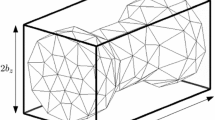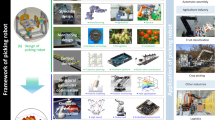Abstract
Automobile flexible sheet metal parts are prone to produce non-negligible grasping deformation, and choosing an appropriate layout of grasping points is an important means to reduce the grasping deformation for sheet metal parts. It is challenging to optimize the layout of grasping points efficiently and accurately because of the large number of robot fingers due to a large size sheet part. In order to improve the optimization efficiency and reduce the computational cost, this paper proposes a two-stage optimization design method for the layout of grasping points based on GSA-Kriging surrogate model. First, the number of robot fingers and their feasible range are determined according to the stability of robotic grasping operation and the degree of deformation at different positions. Then, according to the position distribution of grasping points, they are divided into two stages for optimization. Finally, GSA-Kriging surrogate model and gravitational search algorithm (GSA) are used to find the optimal layout of grasping points. In this paper, the layout of grasping point optimization of a certain car door sheet part is utilized as a case to validate the proposed method and we have designed an experimental system to test the proposed grasp method on a curved sheet part. The result shows that the GSA-Kriging surrogate model is more accurate and more stable than Kriging and other surrogate models. At the same time, the two-stage optimization method improves the optimization efficiency while reducing the calculation cost and burden.























Similar content being viewed by others
Data availability
The datasets used or analyzed during the current study are available from the corresponding author on reasonable request.
Code availability
The code during the current study are available from the corresponding author on reasonable request.
References
Krishnakumar K, Melkote SN (2000) Machining fixture layout optimization using the genetic algorithm. Int J Mach Tools Manuf 40(4):579–598. https://doi.org/10.1016/s0890-6955(99)00072-3
Kashyap S, Devries WR (1999) Finite element analysis and optimization in fixture design. Struct Multidiscip O 18(2–3):193–201. https://doi.org/10.1007/s001580050120
Li GL, Du SC, Huang DL, Zhao C, Deng YF (2019) Elastic mechanics-based fixturing scheme optimization of variable stiffness structure workpieces for surface quality improvement. Precis Eng 56:343–363. https://doi.org/10.1016/j.precisioneng.2019.01.004
Kulankara K, Satyanarayana S, Melkote SN (2002) Iterative fixture layout and clamping force optimization using the genetic algorithm. J Manuf Sci Eng-Trans Asme 124(1):119–125. https://doi.org/10.1115/1.1414127
Xing YF, Hu M, Zeng H (2015) Fixture layout optimization based on a non-domination sorting social radiation algorithm for auto-body parts. Int J Prod Res 53(11):3475–3490. https://doi.org/10.1080/00207543.2014.1003662
Zhou T, Xiong ZQ, Yao W, Qin Y (2016) Flexible tooling layout optimization for thin-walled workpieces based on improved ant colony algorithm. J Propuls Technol 37(6):1165–1174. https://doi.org/10.13675/j.cnki.tjjs.2016.06.022
Liao YG (2003) A genetic algorithm-based fixture locating positions and clamping schemes optimization. Proc IME Part B-J Eng Manuf 217(8):1075–1083. https://doi.org/10.1177/095440540321700805
Huang Q, Srijana Y, Gao S, Xu ZW, Wang XY (2018) Analysis of adaptive clamping force of fixture based on finite element method. IOP Conference Series: Mater Sci Eng 423(1):1–13. https://doi.org/10.1088/1757-899X/423/1/012116
Xing YF (2017) Fixture layout design of sheet metal parts based on global optimization algorithms. J Manuf Sci E-T Asme 139(10):1–10. https://doi.org/10.1115/1.4037106
Milad K, Maryam GS, Abdolreza O (2020) Multi-objective optimization of auto-body fixture layout based on an ant colony algorithm. P I Mech Eng C-J Mec 234(6):1137–1145. https://doi.org/10.1177/0954406219891756
Vishnupriyan S, Majumder MC, Ramachandran KP (2011) Optimal fixture parameters considering locator errors. Int J Prod Res 49(21):6343–6361. https://doi.org/10.1080/00207543.2010.532167
Wang H, Huang LJ (2015) Integrated analysis method of thin-walled turbine blade precise machining. Int J Precis Eng Man 16(5):1011–1019. https://doi.org/10.1007/s12541-015-0131-0
Hamedi M (2005) Intelligent fixture design through a hybrid system of artificial neural network and genetic algorithm. Artif Intell Rev 23(3):295–311. https://doi.org/10.1007/s10462-004-7187-z
Sundararaman K, Padmanaban K, Sabareeswaran M (2016) Optimization of machining fixture layout using integrated response surface methodology and evolutionary techniques. P I Mech Eng C-J Mec 230(13):2245–2259. https://doi.org/10.1177/0954406215592920
Qin G, Wang Z, Rong Y (2017) A unified approach to multi-fixturing layout planning for thin-walled workpiece. P I Mech Eng B-J Eng 231(3):454–469. https://doi.org/10.1177/0954405415585240
Yang Y, Wang ZQ (2017) Prediction model for aeronautical thin-walled part fixture layout optimization based on SVR. Comput Integr Manuf Syst 23(06):1302–1309. https://doi.org/10.13196/j.cims.2017.06.016
Su J, Cao E, Hong Q (2014) Optimization of fixture layouts of glass laser optics using multiple kernel regression. Appl Opt 53(14):2988–2997. https://doi.org/10.1364/ao.53.002988
Rex FMT, Ravindran D (2017) An integrated approach for optimal fixture layout design. P I Mech Eng B-J Eng 231(7):1217–1228. https://doi.org/10.1177/0954405415590991
Wang ZQ, Yang Y, Yang B, Kang YG (2016) Optimal sheet metal fixture locating layout by combining radial basis function neural network and bat algorithm. Adv Mech Eng 8(12):217–233. https://doi.org/10.1177/1687814016681905
Dini G, Failli F (2000) Planning grasps for industrial robotized applications using neural networks. Robot Comput Integr Manuf 16(6):451–463. https://doi.org/10.1016/s0736-5845(00)00021-1
Qi ZC, Zhang KF, Li Y, Cheng H (2015) Analysis and optimization for locating errors of large wing panel during automatic drilling and riveting. Acta Aeronautica et Astronautica Sinica 36(10):3439–3449. https://doi.org/10.7527/S1000-6893.2015.0221
Aderiani AR, Wrmefjord K, Sderberg R (2020) Optimal design of fixture layouts for compliant sheet metal assemblies. Int J Adv Manuf Technol 110(7):2181–2201. https://doi.org/10.1007/s00170-020-05954-y
Yu KG (2019) Robust fixture design of compliant assembly process based on a support vector regression model. Int J Adv Manuf Technol 103(1–4):111–126. https://doi.org/10.1007/s00170-019-03488-6
Lu C, Wang Y (2017) Positioning variation analysis for the sheet metal workpiece with N-2-1 locating scheme. Int J Adv Manuf Technol 89(9–12):3021–3035. https://doi.org/10.1007/s00170-016-9284-y
Xiong CH (2007) Fundamentals of robotic grasping and fixturing. World Scientific
Xiong CH, Li YF, Ding D, Xiong YL (1999) On the dynamic stability of grasping. Int J Robot Res 18(9):951–958
Wan XJ, Yang JQ, Zhang HJ (2018) Optimization of fixture layout based on error amplification factors. J Comput Inf Sci Eng 18(4):041007. https://doi.org/10.1115/1.4040607
Sacks J, Welch WJ, Mitchell TJ (1989) Design and analysis of computer experiments. Stat Sci 4(4):409–423
Nielsen HB, Lophaven SN, Sondergaard J (2002) DACE, a MATLAB kriging toolbox
Rashedi E, Nezamabadi-Pour H, Saryazdi S (2009) GSA: a gravitational search algorithm
Acknowledgements
The authors would like to thank the Fund of the National Natural Science Foundation of China (Grant no. 52075403).
Funding
Supported by the National Natural Science Foundation of China (Grant no. 52075403).
Author information
Authors and Affiliations
Contributions
Investigation, data collection, and analysis were performed by Chenxi Zhu. Xiao-Jin Wan was in charge of the whole trial. Zhengjie Zhou participated in the revision of the first draft of the manuscript. All authors read and approved the final manuscript.
Corresponding author
Ethics declarations
Ethics approval
Not applicable.
Consent to participate
Not applicable.
Consent for publication
All the authors have reached agreement for publication.
Competing interests
The authors declare no competing interests.
Additional information
Publisher's note
Springer Nature remains neutral with regard to jurisdictional claims in published maps and institutional affiliations.
Rights and permissions
Springer Nature or its licensor (e.g. a society or other partner) holds exclusive rights to this article under a publishing agreement with the author(s) or other rightsholder(s); author self-archiving of the accepted manuscript version of this article is solely governed by the terms of such publishing agreement and applicable law.
About this article
Cite this article
Zhu, C., Wan, XJ. & Zhou, Z. Grasping point optimization for sheet metal part based on GSA-Kriging model in a multi-robot assembly system. Int J Adv Manuf Technol 125, 2225–2242 (2023). https://doi.org/10.1007/s00170-023-10835-1
Received:
Accepted:
Published:
Issue Date:
DOI: https://doi.org/10.1007/s00170-023-10835-1




